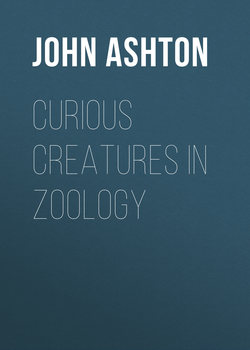Читать книгу Curious Creatures in Zoology - Ashton John - Страница 11
CURIOUS CREATURES
The Sphynx
Оглавление“The Sphynga or Sphinx, is of the kind of Apes, but his breast up to his necke, pilde and smooth without hayre: the face is very round, yet sharp and piked, having the breasts of women, and their favor, or visage, much like them: In that part of the body which is bare with out haire, there is a certaine red thing rising in a round circle, like millet seed, which giveth great grace & comeliness to their coulour, which in the middle part is humaine: Their voice is very like a man’s, but not articulate, sounding as if one did speake hastily, with indignation or sorrow. Their haire browne, or swarthy coulour. They are bred in India, and Ethiopia. In the promontory of the farthest Arabia neere Dira, are Sphinges, and certaine Lyons, called Formicæ, so, likewise, they are to be found amongest the Trogloditæ.
“As the Babouns and Cynocephali are more wilde than other Apes, so the Satyres and Sphynges are more meeke and gentle, for they are not so wilde that they will not bee tamed, nor yet so tame, but they will revenge their own harmes; as appeared by that which was slayne in a publike spectacle among the Thebanes. They carrye their meat in the store houses of their own chaps or cheeks, taking it forth when they are hungry, and so eat it.
“The name of this Sphynx is taken from ‘binding,’ as appeareth by the Greek notation, or else of delicacie and dainty nice loosnesse, (wherefore there were certain common strumpets called Sphinctæ, and the Megarian Sphingas was a very popular phrase for notorious harlots), hath given occasion to the poets to faigne a certaine monster called Sphynx, which they say was thus derived. Hydra brought foorth the Chimæra, Chimæra by Orthus, the Sphynx, and the Nemæan Lyon: now, this Orthus was one of Geryon’s dogges. This Sphynx they make a treble formed monster, a Mayden’s face, a Lyon’s legs, and the wings of a fowle; or, as Ansonius and Varinus say, the face and head of a mayde, the body of a dogge, the winges of a byrd, the voice of a man, the clawes of a Lyon, and the tayle of a dragon: and that she kept continually in the Sphincian mountaine; propounding to all travailers that came that way an Ænigma, or Riddle, which was this: What was the creature that first of all goeth on foure legges; afterwards on two, and, lastly, on three: and all of them that could not dissolve that Riddle, she presently slew, by taking them, and throwing them downe headlong, from the top of a Rocke. At last Œdipus came that way, and declared the secret, that it was a man, who in his infancy creepeth on all foure, afterward, in youth, goeth upon two legs, and last of all, in olde age taketh unto him a staffe which maketh him to goe, as it were, on three legs; which the monster hearing, she presently threwe down herselfe from the former rocke, and so she ended. Whereupon Œdipus is taken for a subtill and wise opener of mysteries.
“But the truth is, that when Cadmus had married an Amazonian woman, called Sphynx, and, with her, came to Thebes, and there slew Draco their king, and possessed his kingdom, afterwards there was a sister unto Draco called Harmona, whom Cadmus married, Sphynx being yet alive. She, in revenge, (being assisted by many followers,) departed with great store of wealth into the mountaine Sphincius, taking with her a great Dogge, which Cadmus held in great account, and there made daily incursions or spoiles upon his people. Now, ænigma, in the Theban language, signifieth an inrode, or warlike incursion, wherfore the people complained in this sort. This Grecian Sphinx robbeth us, in setting up with an ænigma, but no man knoweth after what manner she maketh this ænigma.
“Cadmus hereupon made proclamation, that he would give a very bountifull reward unto him that would kill Sphinx, upon which occasion the Corinthian Œdipus came unto her, being mounted on a swift courser, and accompanied with some Thebans in the night season, slue her. Other say that Œdipus by counterfaiting friendshippe, slue her, making shew to be of her faction; and Pausanius saith, that the former Riddle, was not a Riddle, but an Oracle of Apollo, which Cadmus had received, whereby his posterity should be inheritors of the Theban kingdome; and whereas Œdipus, being the son of Laius, a former king of that countrey, was taught the Oracle in his sleepe, he recouvered the kingdome usurped by Sphinx his sister, and, afterwards, unknown, married his mother Jocasta.
“But the true morall of this poetical fiction is by that learned Alciatus, in one of his emblems, deciphered; that her monstrous treble formed shape signified her lustfull pleasure under a Virgin’s face, her cruell pride, under the Lyon’s clawes, her winde-driven leuitye, under the Eagles, or birdes feathers, and I will conclude with the wordes of Suidas concerning such monsters, that the Tritons, Sphinges, and Centaures, are the images of those things, which are not to be founde within the compasse of the whole world.”
